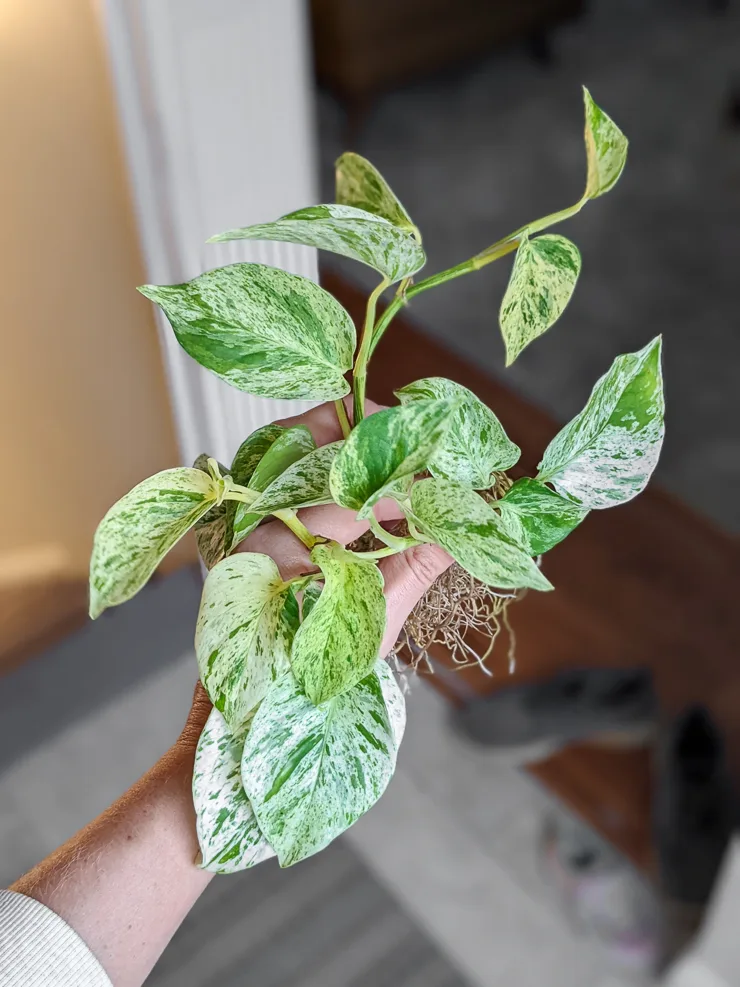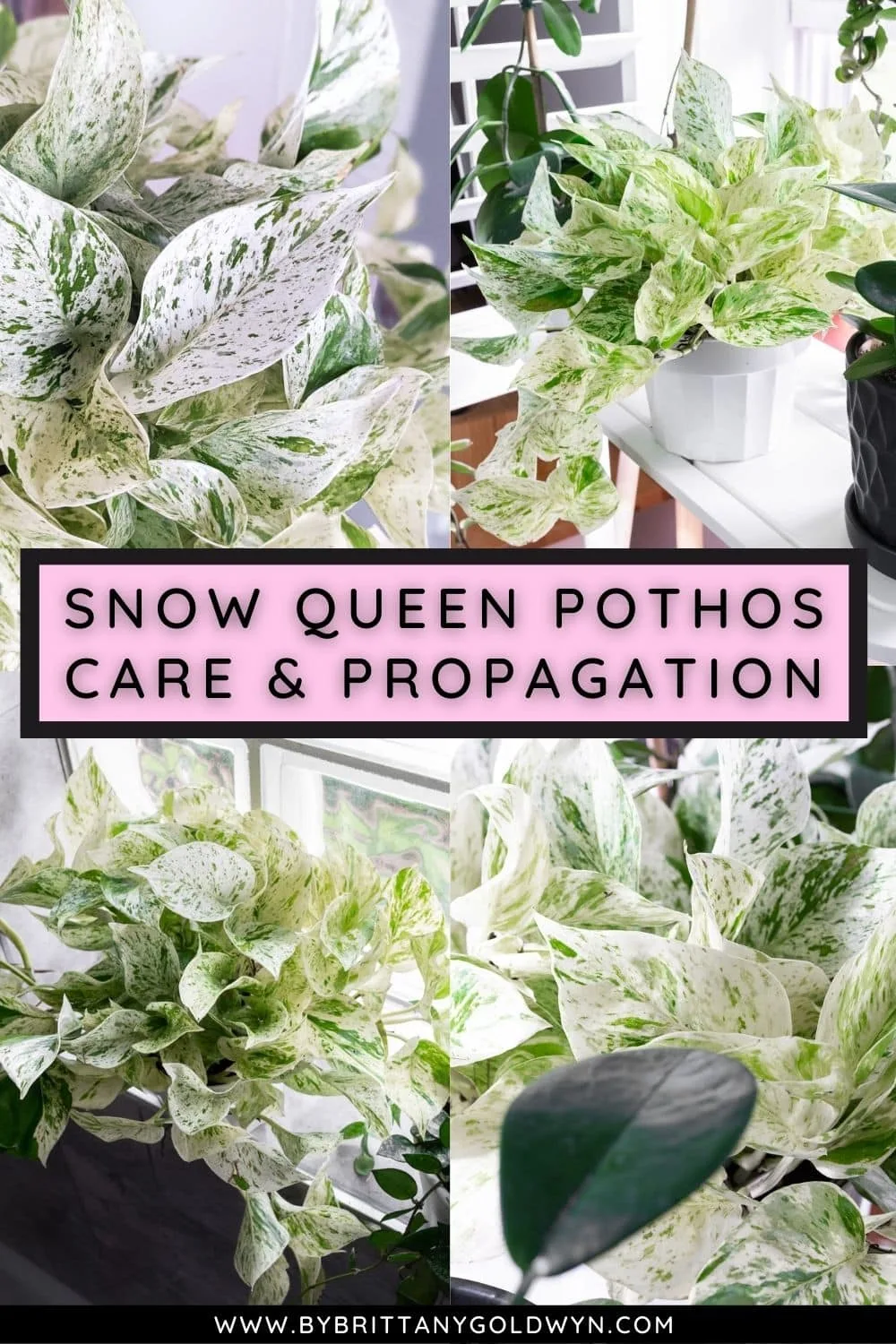Temperature & humidity
The snow queen pothos plant’s temperature and humidity needs also mirror those of other epipremnum aureum family members, with one caveat. Snow queen will benefit from some extra humidity, which will help prevent the super white parts of the leaves from browning.
Extra humidity along with great light and warm temperatures work together to keep those leaves white. If you notice browning, crispy spots on the leaves—especially the white parts—consider your humidity levels.
That said, this plant generally does well in all household humidity levels. It is a patient pothos, after all. Just monitor it for any issues and adjust as necessary.
As for temperature levels, it also does well in a variety of normal household temperatures. Between 60 and 85 degrees Fahrenheit is best. As a tropical plant, though, it definitely enjoys warmer temperatures. This plant is not cold or frost hardy and will die if temperatures are consistently below 50 degrees.
I like to take some of my pothos plants outdoors for the spring and summer so they can soak up the warm, humid Maryland summers. But they need to come back inside in the fall—at least where I live.


Snow queen pothos growth rate & repotting needs
As a variegated plant, snow queen pothos is generally a slower grower—at least when compared to some of its relatives, which grow like absolute weeds. (And in some cases grow so prolifically that they have become invasive, like some areas in Florida.)
Plenty of bright indirect light will help speed up this plant’s growth. If you have it in medium or lower light levels, its growth rate will definitely slow down.
Boosting humidity levels will also help the snow queen’s growth, especially as it relates to leaf size. I am always astounded by how large my pothos plant leaves get when I have them outside in our super humid summers! It always makes me a little sad when I have to bring my plants inside for their long, sad winter.
I recommend repotting your snow queen pothos every few years and sizing up only an inch or two when you do. I wait until the roots begin growing out of the pot’s bottom to repot, too. Otherwise, it still has a bit of room to grow, and there’s no need to disturb it.
When you do repot your snow queen, make sure to use fresh soil to replenish its nutrients.

Want more pothos? Check out my Baltic Blue Pothos Care & Propagation guide, my Epipremnum Pinnatum Variegata Albo Propagation & Care, and my Cebu Blue Pothos Care & Propagation!
Fertilizer—is it necessary?
And speak of nutrients, pothos plants generally do not need to be fertilized as long as you use a high-quality soil that has nutrients in it. However, nutrients to deplete over time, so if you haven’t repotted your pothos plant in a while, fertilizer can be helpful.
I recommend using something like organic worm castings that you can work into the top layer of soil. When you water the plant, the nutrients will disperse throughout the plant’s root system.
I’ve also started using Liqui-Dirt roughly every three or four times I water my houseplants, too. I like using this highly concentrated fertilizer because I can just pour a bit in my watering can.
It isn’t a chemical fertilizer either, so you don’t have to worry about over-fertilizing your plants and burning them. It’s good stuff, and my plants seem to be really happy with it added to their care routine.

How to propagate a snow queen pothos
Snow queen pothos plants are quite easy to propagate from cuttings. Simply take a cutting of your plant that has roughly 2–3 leaves and 1–2 nodes.
You can take a cutting that has a little bump on the stem where an aerial root would eventually grow, or you can take a cutting and remove the lower-most set of leaves to expose growth points. Then it’s time to prepare your medium.
Water propagation
Pothos cuttings are so easy to propagate that you can just pop the cutting into water and wait. Refresh the water every week or so, and make sure the growth points are always submerged in water.
Once the cutting has roots that are several inches long, you can transplant the cutting to soil. Keep the soil moist as the cutting’s water roots acclimate to soil and transition. Don’t worry if your cutting wilts a bit—it will rebound.
After the cutting takes root, you can begin treating your new snow queen pothos plant as normal.


Moss propagation
I also like using moss as a propagation medium for pothos cuttings. The roots generally grow stronger, and the plant doesn’t suffer as much transplant shock when you transfer it to soil.
To propagate a pothos cutting using moss, simply wet sphagnum moss and squeeze out all of the excess water. The moss should remain moist. Mix with some perlite and put in a little cup. Add the cutting and keep a clear baggie over the cutting—or add it to a DIY plastic propagation box.
Ensure the moss stays moist and the environment remains humid to encourage root growth. Once you have roots, you can transfer the cutting to soil just as you’d do with a water propagation. (For more on this, check out my Sphagnum Moss Propagation 101 post.)

Pest issues to be aware of
Snow queen pothos plants are not terribly vulnerable to pests. Just the normal houseplant pests you might encounter, and they’ll likely either enter your home on another plant and spread to the snow queen or come as a terrible bonus gift on your new snow queen.
Mealybugs are some of the most common pothos pests. They look like white cotton masses on your plant, most notably where the leaves meet the stems. See my post for more on identifying mealybugs and getting rid of them.
Fungus gnats are another common household pest that are more annoying than they are harmful. They can also signal an overwatering issue in your care routine because they lay eggs in moist soil. To get rid of them, make sure you are letting the top few inches of soil dry out!
I have a post all about how to get rid of gnats in houseplants, and it also includes what causes them. Check that out for a detailed post on the topic.
Toxicity
Pothos plants in general are considered mildly toxic when ingested, and this includes snow queen pothos. Keep this plant away from both pet and human nibblers.
Pin my snow queen pothos care guide!







